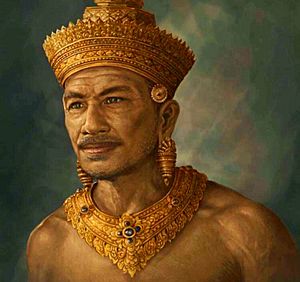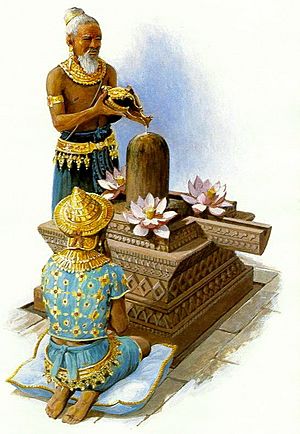Jayavarman II facts for kids
Quick facts for kids Jayavarman II |
|
|---|---|
 |
|
| King of the Khmer Empire | |
| Reign | 802 – 835 |
| Successor | Jayavarman III |
| Born | ca. 770 |
| Died | 835 (aged 64–65) Angkor, Khmer Empire (now in Siem Reap, Cambodia) |
| Issue | Jyeṣṭhāryā, Jayavarman III |
| Religion | Hinduism |
Jayavarman II (Khmer: ជ័យវរ្ម័នទី២; around 770 – 835 AD) was an important king from the 9th century. He ruled what is now Cambodia. Many people see him as the founder of the Khmer Empire. This empire was a very powerful civilization in Southeast Asia for hundreds of years.
King Jayavarman II helped unite Cambodia. Before he became king, different local leaders fought for control. The country was not together under one ruler. He was a strong leader who ended the rule of the Shailendra Dynasty from Java. Later kings of the Khmer Empire remembered him as a great warrior. They saw him as the most powerful king of his time.
Contents
How Jayavarman II Became King
Jayavarman II is known for starting the Angkor period in Cambodian history. This period began with a special ceremony in 802 AD. The ceremony happened on a sacred mountain called Mahendraparvata, now known as Phnom Kulen. This event celebrated Cambodia's freedom from the rule of Java.
During this ceremony, Prince Jayavarman II was declared a "universal monarch." This means he was seen as the king of the world. He was also called a "God King" (Deva Raja). Some stories say Jayavarman II lived in Java for a while. He might have learned the idea of a God King there. At that time, the Sailendras, or "Lords of Mountains," ruled over Java and parts of Cambodia.
An old stone carving from the Sdok Kak Thom temple tells more about this. It says that on Mahendraparvata, Jayavarman II took part in a special ritual. A wise priest named Hiranyadama and his chief priest, Lord Sivakaivalya, performed it. This ritual made Jayavarman II a chakravartin, which means "Lord of the Universe."
Building the Empire
Jayavarman II started the first important settlement of the Angkor empire. It was called Hariharalaya and was near a place called Roluos today. Even though he was very important, we don't have many clear facts about him. No writings from him have been found. But many later writings mention him.
He was likely born into a noble family. He began his journey of taking control in the southeast of Cambodia. One old writing says he "rose like a new flower" for the good of his people. Other writings say he married a woman named Hyang Amrita. He also started a religious place in the southeast.
Records suggest that Jayavarman and his followers moved over many years. They went from southeast Cambodia to the northwest. Along the way, they took control of different small kingdoms. A historian named Claude Jacques says he first took the city of Vyadhapura. Then he moved along the Mekong River to take Sambhupura.
Later, he settled in another city, now called Banteay Prei Nokor. This city is near modern-day Kompong Cham. Jacques believes he then moved to Wat Pu in southern Laos. After that, he traveled along the Dangrek Mountains to reach the Angkor area.
He faced strong resistance from local leaders in the west. They pushed him to seek safety on Phnom Kulen. This is where the priest declared Cambodia an independent state. This step might have helped Jayavarman show his power against those who opposed him.
Once he was in the Angkor region, he ruled from Hariharalaya. This city was just north of the Tonle Sap lake. He also ruled from a place called Amarendrapura. We don't know exactly where Amarendrapura was. Some historians think it was a lost city at the western end of the West Baray. The West Baray is a huge holy water reservoir built much later.
No single temple is definitely linked to Jayavarman II. But some historians think he might have built Ak Yum. This was a brick pyramid that is mostly in ruins today. It was located at the southern edge of the West Baray. This temple was an early example of the "mountain-temple" style that later Khmer kings used.
The Sdok Kak Thom Inscription
The most helpful writing about Jayavarman II was found in 1052 AD. This was two centuries after he died. It was found at the Sdok Kak Thom temple in modern-day Thailand.
The writing says, "When His Majesty Paramesvara came from Java to rule in the royal city of Indrapura... Sivakaivalya, the family's purohit (chief priest), was serving as his teacher." It uses the king's name after his death.
Later, the text says a priest named Hiranyadama came from Janapada. He was "skilled in magic power." Jayavarman II invited him to perform a special ceremony. This ceremony would free Kambujadesa (the kingdom) from Java's control. The writing also tells about the creation of the devaraja cult. This was a very important religious ceremony for Jayavarman's court and later Khmer people.
Jayavarman II's Legacy
Historians still discuss how much Jayavarman II's rule changed Khmer history. Was it a major turning point that created one independent state from many small ones? Or was it just one step in a long process?
What is clear is that later Khmer kings saw him as a very important first king. They used his legacy to show their own right to rule. However, Hindu civilization had been in the region for centuries before him. The fact that he was "Jayavarman II" shows there were already important kings in the area before him.
After His Reign
Jayavarman II died in 835 AD. He was given the special name Parameshwara after his death. This name means "the supreme ruler" and is also a name for the god Sri Shiva.
After him, his son Jayavarman III became king. Two other kings from the family he married into also ruled. Jayavarman II and these kings and their wives were honored at the Preah Ko temple in Roulous. King Indravarman I built this temple, and it was opened in 880 AD.
See also
 In Spanish: Jayavarman II para niños
In Spanish: Jayavarman II para niños


